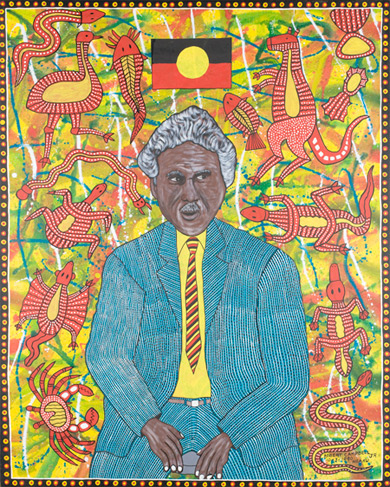Neville Bonner
The Aboriginal flag was designed by Harold Thomas. It was first flown on National Aborigines Day in Adelaide in 1971, the same year that Neville Bonner became Australia’s first Indigenous parliamentarian. The Aboriginal flag was officially recognised under federal legislation in 1995.
The colours red, yellow and black are repeated throughout the portrait.
What do these colours symbolise on the Aboriginal flag?
The artist recognises Bonner’s association with the federal government by including his own interpretation of the Australian coat of arms. The emblematic emu and kangaroo flank the Aboriginal flag that, in Campbell’s version, has replaced the national shield.
Does your school have an official crest or motto?
Create your own version of the Australian coat of arms.
Bonner’s pose is directed towards the viewer, but his attention is focussed elsewhere. Beneath his trademark moustache, his open mouth suggests he still has much to say.
What words would you use to describe Bonner’s pose and expression?
What do you think he might have to say?
Particular animals are often associated with different groups of Indigenous people as totems. The native animals in the portrait may represent Aboriginal totems, clans or Bonner’s kinship with all groups. The artist also includes the shellfish and crab, a reference perhaps to the river mouth where Bonner’s own mob, the Jagera people, live.
What animals can you identify in the portrait?
What do you think they represent?
Move your mouse over the portrait to
see the points of interest.
About the artist
Robert Campbell Jnr was a Ngaku/Dhunghutti man who grew up in Kempsey, NSW. A self-taught artist, Campbell gained recognition for his work in the 1980s after successful exhibitions in Sydney and Melbourne.
Influenced by his travels to the Aboriginal community of Ramingining, Campbell began making portraits in the late 1980s. Two of these were selected as finalists in the Archibald Prize in 1989 and 1990.


